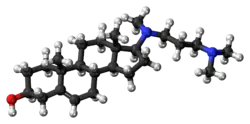Azacosterol
Azacosterol (INNTooltip International Nonproprietary Name), or azacosterol hydrochloride (USANTooltip United States Adopted Name) (brand name Ornitrol), also known as 20,25-diazacholesterol, is a cholesterol-lowering drug (hypocholesteremic), which was marketed previously, but has since been discontinued.[1][2][3] It is also an avian chemosterilant used to control pest pigeon populations via inducing sterility.[4] The drug is a sterol and derivative of cholesterol in which two carbon atoms have been replaced with nitrogen atoms.[5]
 | |
 | |
| Clinical data | |
|---|---|
| Other names | 20,25-Diazacholesterol; 20,25-Azacholesterol; Azasterol; Diazasterol; SC-12937; DAC; IMD-760; 17β-(3-(Dimethylamino)propyl)methyl- amino)androst-5-en-3β-ol |
| Routes of administration | By mouth |
| Identifiers | |
| |
| CAS Number |
|
| PubChem CID | |
| ChemSpider | |
| UNII | |
| ChEMBL | |
| CompTox Dashboard (EPA) | |
| Chemical and physical data | |
| Formula | C25H44N2O |
| Molar mass | 388.640 g·mol−1 |
| 3D model (JSmol) | |
| |
| |
| | |
Azacosterol acts as an inhibitor of 24-dehydrocholesterol reductase (24-DHCR), preventing the formation of cholesterol from desmosterol.[4][6] Although it primarily acts to inhibit 24-DHCR, the drug also inhibits other steps in cholesterol biosynthesis.[6] The antifertility effects of the drug in birds are mediated by inhibition of steroid hormone production, steroid hormones being synthesized from cholesterol.[4] Due to prevention of the metabolism of desmosterol, the drug causes it to accumulate, in turn producing side effects such as hyperkeratosis, particularly of the palms and soles.[6]
See also
References
- Elks J (14 November 2014). The Dictionary of Drugs: Chemical Data: Chemical Data, Structures and Bibliographies. Springer. pp. 110–. ISBN 978-1-4757-2085-3.
- Morton IK, Hall JM (31 October 1999). Concise Dictionary of Pharmacological Agents: Properties and Synonyms. Springer Science & Business Media. pp. 43–. ISBN 978-0-7514-0499-9.
- William Andrew Publishing (22 October 2013). Pharmaceutical Manufacturing Encyclopedia (3rd ed.). Elsevier. pp. 463–. ISBN 978-0-8155-1856-3.
- Singh H, Kapoor VK, Paul D (January 1979). "Heterosteroids and drug research". Progress in Medicinal Chemistry. 16: 35–149. doi:10.1016/s0079-6468(08)70187-5. ISBN 9780720406672. PMID 95596.
- Counsell RE, Klimstra PD, Ranney RE (November 1962). "Hypocholesterolemic Agents. III.1N-Methyl-N-(dialkylamino)alkyl-17β-aminoandrost-5-en-3β-ol Derivatives". Journal of Medicinal and Pharmaceutical Chemistry. 91 (6): 1224–33. doi:10.1021/jm01241a014. PMID 14056455.
- Williams ML (21 January 2016). "Lipids in normal and pathological desquamation". In Elias PM (ed.). Advances in Lipid Research: Skin Lipids. Elsevier. pp. 218–220. ISBN 978-1-4832-1545-7.